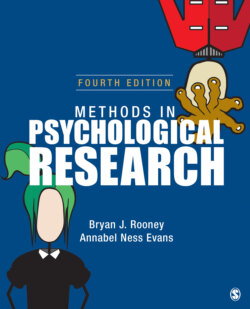Читать книгу Methods in Psychological Research - Annabel Ness Evans - Страница 82
На сайте Литреса книга снята с продажи.
Descriptive Statistics
ОглавлениеDescriptive statistics include measures of central tendency, variability, and the strength of the relationship between variables. The mean, median, and mode are the most common measures of central tendency. The mean (symbolized as M) is the arithmetic average. It is what we report when talking about the class average on a test, for example. The median (symbolized as Mdn) is the value that half the observations (or scores) exceeded and half were below. It is the middle score in a distribution of scores arranged from lowest to highest. The median is often reported when a distribution of scores is not bell shaped (i.e., not a normal distribution). The mode (symbolized as Mo) is the most frequently occurring score or value in your data. The mode gives us a measure of the typical value in the distribution. For example, if you were making a “one-size-fits-all” pair of eyeglasses, you would want the mode for head size. Each measure of central tendency uses a different approach to describe the average of a group of scores.
The most common statistics used for describing variability in data are the range, variance, and standard deviation. The range either is reported as the highest and lowest score or is reduced to a single value that is the distance between these two scores. On an exam, you may ask what was the highest score attained, and perhaps out of morbid curiosity, you may want to know the lowest score as well. The range is an appropriate measure of variability for some types of data, but it is quite crude. For example, there may be one very high score and one very low score, and the range will not indicate that perhaps all the other scores were concentrated very near the mean. Two related measures of variability provide this information. The variance and its square root, the standard deviation (symbolized as SD), provide a measure of the average distance scores are from the mean. With data that are bell shaped or normally distributed, the standard deviation tells us where the bulk of the scores fall; about two thirds of the scores fall between 1 standard deviation above the mean and 1 standard deviation below the mean. More detail on the calculation and appropriate selection of these statistics is given in Chapters 4 and 13.
Often you will read research articles that describe the degree to which variables are related to one another. The most common measure of association is the Pearson product–moment correlation (symbolized as r). This statistic describes how strongly (or weakly) variables are related to one another. For example, if two variables are perfectly correlated, the r value will be 1 or –1. The sign of the number indicates the direction of the relationship. A positive correlation tells us that the variables are directly related; as one variable increases, so does the other, and as one variable decreases, so does the other. A negative correlation tells us that the variables are inversely related. That is, as one variable increases, the other decreases, and as one variable decreases, the other increases. The magnitude of r tells us how strongly the variables are related. A zero correlation tells us that the variables are not related at all; as the value increases to +1 or decreases to –1, the strength of the relationship increases. A correlation of 1 (either positive or negative) is called a perfect correlation.Be aware that perfect correlations never actually occur in the real world. If they do, it usually means that you have inadvertently measured the same variable twice and correlated the data. For example, you would likely get a correlation of 1 if you measured reaction time in seconds and also in minutes. It would be no surprise to find that the values are correlated because they are the same measure, only in different scales. Here is another example: Suppose you measured mood with two scales. It is likely that the measures will correlate highly. Again, this only indicates that you have two measures of the same thing.
These descriptive statistics are used to summarize what was observed in the research. But the idea of a lot of research is to generalize the findings beyond just the observations or participants in the study. We ultimately want to say something about behavior in general, not just the behavior that occurred in the study. To make these generalizations, we need inferential statistics. Before leaping into a list of the various inferential statistics you will likely come across in the literature, we would like to review some of the basic concepts of inference.
